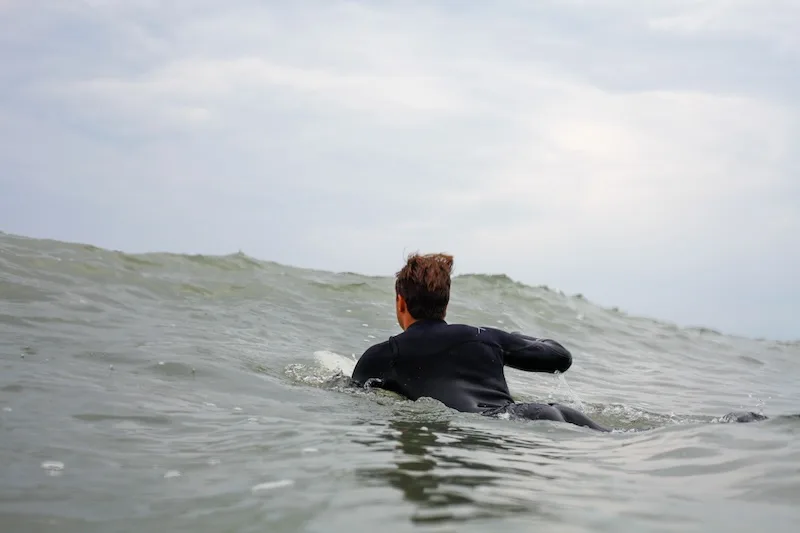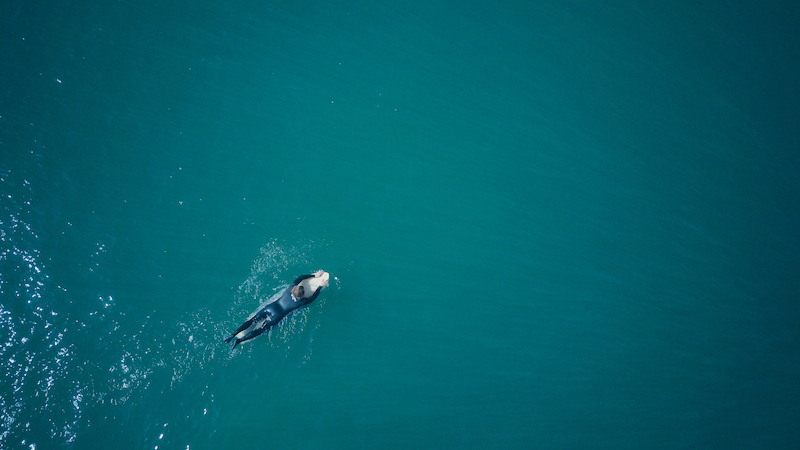Feeling frustrated when paddling out? Do you watch on (angry and jealous) as other surfers speed past you in the line-up, or get out back while you’re still powering through knee-deep whitewater? It’s frustrating. If this sounds like you, here are some very simple, but very effective paddle techniques that can transform your paddle game for the better.
Table of Contents
Surf Paddle Tips - The Basics
Before we dive into the nitty gritty of surf paddle technique, let’s get the basics straight.
Think - Body Position
Whenever you paddle, everything starts with your form, when lying on the board. This will change slightly depending on the board type you’re riding but, you need to make sure the board is resting flat in the water, with the nose slightly poking out the water and your toes (softboard) hanging over the tail or your knees (shortboard).
Most importantly, you need to have your hips in the middle of the board, so the weight isn’t tipping to one rail more than the other. Get a feel for this whenever you surf and ensure your board is flat in the water.
Arch Your Back
As you begin to paddle, arch your back. Not only will this help you see where you’re going, but simultaneously make your paddling more effective. (And helps with your weight distribution). Many new surfers struggle with this, as it requires a degree of flexibility (see some of these stretches to improve your surf flexibility). But this back arch means you can lift your elbows higher, extend your reach as you paddle, and pull more water back with each stroke.

Paddle Down the Rail
As you paddle, brush the rails of the board. Take long smooth strokes, slicing through the water, it should feel smooth and effortless, and each stroke should propel you forward. Sometimes, you can paddle well and do everything correctly but still feel like you’re going nowhere as the current/turbulence might be working against you. Additionally, if you paddle out wide, as it is further away from the rails, this turns the board slightly with each stroke–any side-to-side movement is less movement going forward.
Keep Your Head Still
While it’s tempting to rock your head side to side to exert more effort into each paddle, this side-to-side movement works against you! (Check out this video of Kelly Slater’s paddling). When you keep your head still, there is less air resistance, and your board won’t wobble. Any side-to-side movement is less movement going forward.
Get Good at Duck Diving
Duckiving is a fundamental surfing technique, which requires its own full post–coming soon), that allows surfers to pass under waves. Getting good at duck diving allows you to paddle and dive under waves and resume paddling as quickly as possible, without this technique (or the turtle roll alternative suitable for bigger surfboards), you’ll struggle to make ground and get knocked back every wave.
If you want to take your surfing to the next level and learn all there is to know about surf techniques (from understanding the Ocean to learning about your body and surfing’s fundamentals), check out OMBE surf. They have the widest (and best) range of online surf coaching content on the web. You can check it out here.
Advanced Paddle Technique
Now, we’ve got the basics covered, there are some subtle differences between your everyday surfer and the advanced surfers, paddling rings around you in the line-up. Here are some very small but crucial differences between good and superb paddling.
Make Subtle Body Adjustments
If your body remains glued awkwardly to your board, with your hips out of line and without the ability to adjust, quickly, you’re never going to paddle effectively. When we paddle and get knocked around by waves, duck diving, or even as we paddle, our prime paddle position (hips in the middle, legs together, etc), gets out of whack. But what separates upper-end intermediates and advanced surfer is their ability to (quickly) return to that perfect paddle position. The quicker you can do this, the faster you get back on your board, into position, and out the back!

Watch Your Weight (On Your Board)
Although we always want to have a solid, default paddle position, it’s not always possible, some subtle weight shifts advanced surfers do, whether this be to shift their weight forward slightly when trying to catch flatter waves or shift it back on a steeper one. Or if they’re trying to paddle out quickly to scratch over an oncoming set (insert, scared “Oh shit what should I do” face) they Might also creep forward. Next time you’re surfing, play around with these subtle weight shifts and see what difference it makes to your surf.
Be Dynamic
One of the biggest mistakes things I see when coaching surfers who are catching unbroken waves for the first time, is not having the line-up awareness or where to paddle to different areas of the line-up. For example to the inside to catch some smaller waves or to another peak. To be honest, when paddling is such an effort (due to lack of practice and poor technique) I don’t blame anyone for this.
However, when you’re so comfortable and efficient with your paddling you can paddle all over the line-up, paddle out to catch bigger waves and spin at the last minute to meet the waves, paddle further in between sets to catch smaller waves, spin around and catching insiders on the way back out. This fluidity is why advanced surfers catch so many waves and surf rings around most of the line-up. In your next surf, practice paddling around the line-up and catch waves from different areas.
Final Words
Paddling is one of the most vital aspects of surfing and if you want to take it into the next dimension, implement these tips into your next session. Write a note on your hand, to remind yourself, or pick one thing to work on each session! You’ll be surprised at what a difference these subtle changes can make to your surfing. For more resources on how to improve your surfing, check out OMBE Surf. They have the widest (and best) range of online surf coaching content on the web. You can check it out here.
